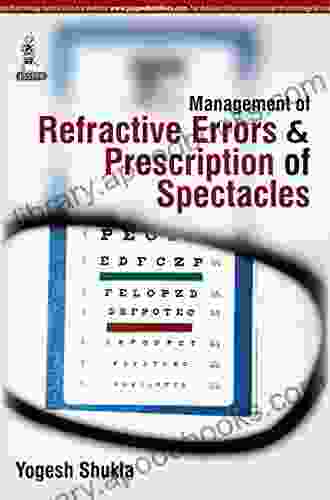Mastering the Art of Vision Correction: A Comprehensive Guide to the Management of Refractive Errors and Prescription of Spectacles

By [Author's Name]
The ability to see clearly is essential for navigating the world and performing everyday tasks. When our vision is blurred or impaired, it can significantly impact our quality of life. Refractive errors are common eye conditions that cause blurred vision and can be easily corrected with the proper prescription of eyeglasses or contact lenses.
5 out of 5
| Language | : | English |
| File size | : | 2917 KB |
| X-Ray for textbooks | : | Enabled |
| Print length | : | 168 pages |
| Screen Reader | : | Supported |
This comprehensive guide will provide a detailed overview of the management of refractive errors and the prescription of spectacles. We will explore the different types of refractive errors, their causes, symptoms, and treatment options. We will also discuss the latest advances in spectacle lens technology and provide tips for choosing the right eyeglasses for your needs.
Understanding Refractive Errors
Refractive errors occur when the shape of the eye prevents light from focusing properly on the retina, the light-sensitive tissue at the back of the eye. This can result in blurred or distorted vision.
There are three main types of refractive errors:
- Myopia (nearsightedness): Nearsighted people can see objects clearly up close, but objects far away appear blurred. This is because the eyeball is too long or the cornea (the clear outer layer of the eye) is too curved, causing light to focus in front of the retina.
- Hyperopia (farsightedness): Farsighted people can see objects clearly far away, but objects up close appear blurred. This is because the eyeball is too short or the cornea is too flat, causing light to focus behind the retina.
- Astigmatism: Astigmatism occurs when the cornea or lens is not perfectly round, causing light to focus in multiple places on the retina. This results in blurred or distorted vision at all distances.
Presbyopia is another common refractive error that occurs with age. It is characterized by the gradual loss of the ability to focus on near objects. This is because the lens of the eye becomes less flexible with age, making it more difficult to change shape to focus on objects at different distances.
Symptoms of Refractive Errors
The symptoms of refractive errors can vary depending on the type and severity of the error.
Common symptoms include:
- Blurred or distorted vision
- Difficulty seeing objects at certain distances
- Squinting or眯眼ing
- Headaches or eye strain
- Double vision
- Difficulty reading or working on a computer
If you are experiencing any of these symptoms, it is important to see an eye doctor for a comprehensive eye exam. Early detection and treatment of refractive errors can help prevent vision loss and other complications.
Diagnosis and Treatment of Refractive Errors
Refractive errors are diagnosed with a comprehensive eye exam. This exam typically includes:
- A visual acuity test to measure your vision at different distances
- A refraction test to determine the type and severity of your refractive error
- An examination of the eye's external and internal structures
Once your refractive error has been diagnosed, your eye doctor will discuss the best treatment options for you. The most common treatment options include:
- Eyeglasses: Eyeglasses are the most common way to correct refractive errors. They are lenses mounted in a frame that you wear over your eyes. Eyeglasses can be made with a variety of lens materials and designs to meet your specific needs.
- Contact lenses: Contact lenses are thin, transparent lenses that you wear directly on your eyes. They can be made of soft or hard materials and come in a variety of shapes and sizes. Contact lenses can provide a wider field of vision than eyeglasses and can be more comfortable for some people.
- Refractive surgery: Refractive surgery is a permanent solution for refractive errors. It uses a laser or other cutting tool to reshape the cornea, changing the way light focuses on the retina. Refractive surgery can be a good option for people who are not satisfied with eyeglasses or contact lenses.
Choosing the Right Eyeglasses
If you choose to wear eyeglasses to correct your refractive error, there are several factors to consider when choosing the right pair.
- Lens material: Eyeglass lenses can be made from a variety of materials, including glass, plastic, and polycarbonate. Glass lenses are the most durable and scratch-resistant, but they are also the heaviest. Plastic lenses are lighter and more impact-resistant, but they are not as scratch-resistant as glass lenses. Polycarbonate lenses are the lightest and most impact-resistant, but they are also the most expensive.
- Lens design: Eyeglass lenses can be designed in a variety of ways to meet your specific needs. Single-vision lenses are used to correct one type of refractive error, such as nearsightedness or farsightedness. Bifocal lenses are used to correct two types of refractive errors, such as nearsightedness and presbyopia. Progressive addition lenses (PALs) are used to correct all types of refractive errors, providing a smooth transition between different viewing distances.
- Frame style: Eyeglass frames come in a variety of styles to suit your taste and personality. Choose a frame that is comfortable to wear and that complements your facial features. It is also important to choose a frame that is made from durable materials and that can withstand everyday wear and tear.
Refractive errors are common eye conditions that can be easily corrected with the proper prescription of eyeglasses or contact lenses. By understanding the different types of refractive errors, their symptoms, and treatment options, you can make the best decision for your vision health.
If you are experiencing any symptoms of a refractive error, be sure to see an eye doctor for a comprehensive eye exam. Early detection and treatment can help prevent vision loss and other complications.
5 out of 5
| Language | : | English |
| File size | : | 2917 KB |
| X-Ray for textbooks | : | Enabled |
| Print length | : | 168 pages |
| Screen Reader | : | Supported |
Do you want to contribute by writing guest posts on this blog?
Please contact us and send us a resume of previous articles that you have written.
 Book
Book Novel
Novel Page
Page Chapter
Chapter Text
Text Story
Story Genre
Genre Reader
Reader Library
Library Paperback
Paperback E-book
E-book Magazine
Magazine Newspaper
Newspaper Paragraph
Paragraph Sentence
Sentence Bookmark
Bookmark Shelf
Shelf Glossary
Glossary Bibliography
Bibliography Foreword
Foreword Preface
Preface Synopsis
Synopsis Annotation
Annotation Footnote
Footnote Manuscript
Manuscript Scroll
Scroll Codex
Codex Tome
Tome Bestseller
Bestseller Classics
Classics Library card
Library card Narrative
Narrative Biography
Biography Autobiography
Autobiography Memoir
Memoir Reference
Reference Encyclopedia
Encyclopedia Jukka Tuhkuri
Jukka Tuhkuri Mike Mavrigian
Mike Mavrigian Laura Onofri
Laura Onofri Phil Croucher
Phil Croucher Phil Shawn
Phil Shawn Juarez M Avelar
Juarez M Avelar Thomas Tryon
Thomas Tryon John Edgar Browning
John Edgar Browning Listastik
Listastik John Drennan
John Drennan John Joe Schlichtman
John Joe Schlichtman Rachel T Pellman
Rachel T Pellman John Varley
John Varley Julia Ridgmont
Julia Ridgmont Joy Ann Reid
Joy Ann Reid Stephen Breyer
Stephen Breyer Jonathan Black
Jonathan Black Robert E Gutsche Jr
Robert E Gutsche Jr Patricia Corrigan
Patricia Corrigan Tim Hillier Graves
Tim Hillier Graves
Light bulbAdvertise smarter! Our strategic ad space ensures maximum exposure. Reserve your spot today!
 Tennessee WilliamsFollow ·3.2k
Tennessee WilliamsFollow ·3.2k Bruce SnyderFollow ·18.3k
Bruce SnyderFollow ·18.3k Harrison BlairFollow ·4.6k
Harrison BlairFollow ·4.6k Steven HayesFollow ·8.7k
Steven HayesFollow ·8.7k Jean BlairFollow ·18.5k
Jean BlairFollow ·18.5k Kurt VonnegutFollow ·3.5k
Kurt VonnegutFollow ·3.5k Wayne CarterFollow ·15.8k
Wayne CarterFollow ·15.8k John SteinbeckFollow ·16.8k
John SteinbeckFollow ·16.8k

 Tyler Nelson
Tyler NelsonHer Dragon to Slay: Embark on an Epic Journey of...
In a realm where shadows dance and legends...

 Zachary Cox
Zachary Cox101 Best Marine Invertebrates: The Adventurous Aquarist's...
Unveiling the Enchanting Realm...

 William Wordsworth
William WordsworthHer Dragon Fire: Unleash the Power Within Your Soul
Embark on an...

 William Powell
William PowellUnveiling the Enchanting World of Machine Embroidery with...
Embroidery, an ancient art form that has...

 Will Ward
Will WardGolden Fire Clan Dragon Guard: A Journey into a Realm of...
Prepare to be...

 Gustavo Cox
Gustavo CoxProject Ideas to Elevate Your Hobbies and Flourish Your...
<p>Welcome to the ultimate guide to...
5 out of 5
| Language | : | English |
| File size | : | 2917 KB |
| X-Ray for textbooks | : | Enabled |
| Print length | : | 168 pages |
| Screen Reader | : | Supported |












